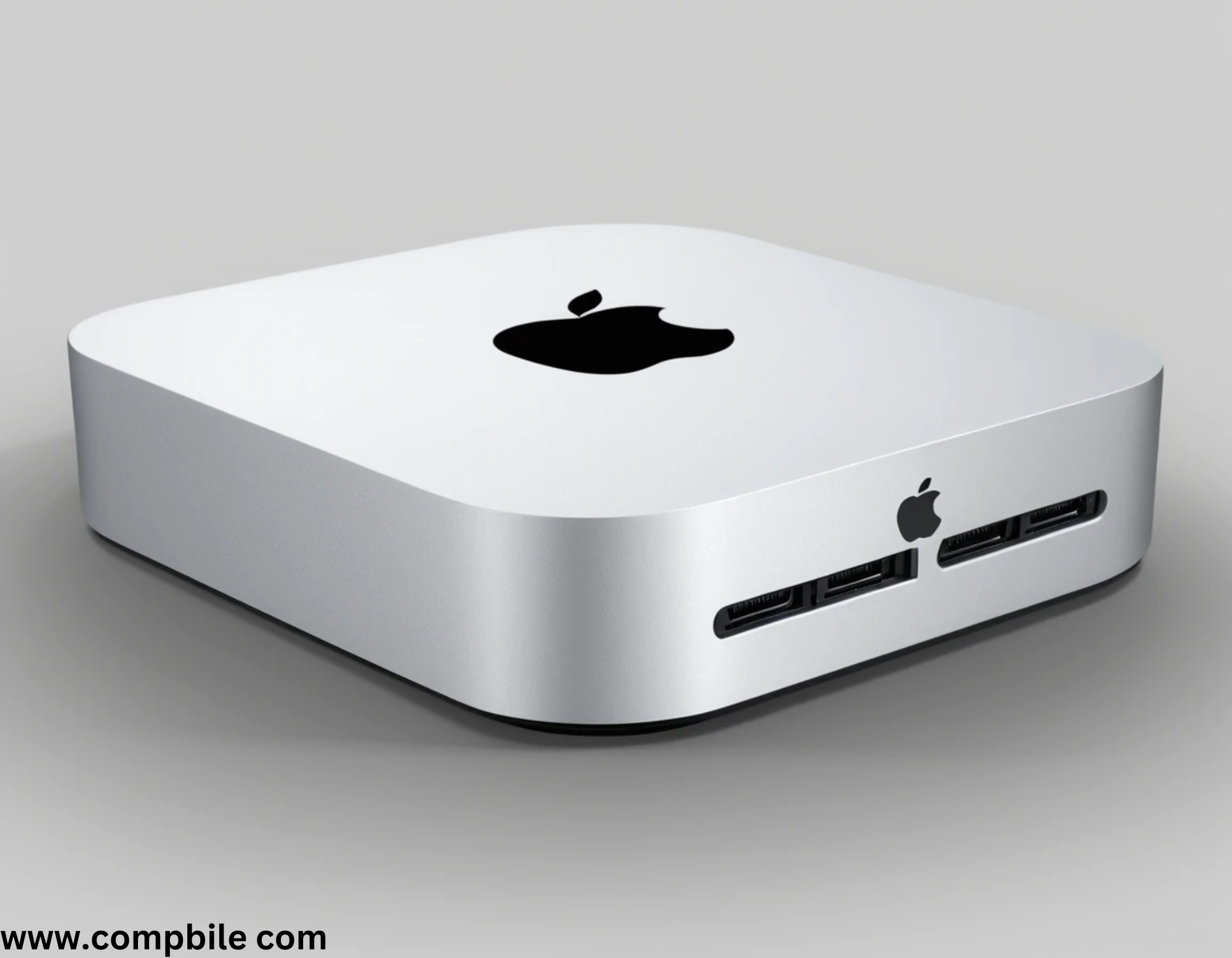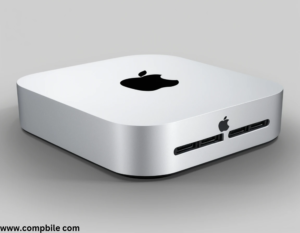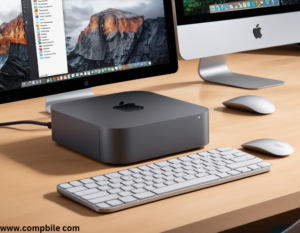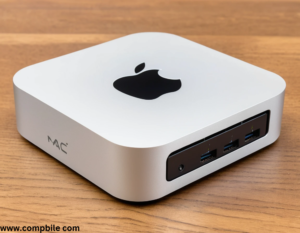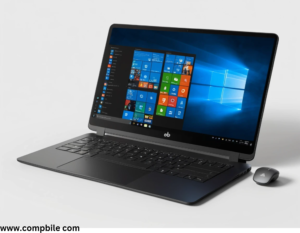Design
Apple Mac Mini Desktop ⇒ The Mac Mini has a sleek, minimalist design with a small footprint, making it an ideal choice for people with limited desk space. The body is made of aluminum, which gives it a premium feel and helps with heat dissipation. Despite its compact size, it’s packed with powerful hardware.
Performance
- M1 and M2 Chips:
- The latest Mac Mini models are powered by Apple’s M1 or M2 chips. These chips have integrated CPU, GPU, and Neural Engine, offering remarkable performance improvements over previous Intel-based models. They’re more energy-efficient as well, so you get a quieter, cooler experience.
- RAM & Storage:
- The M1 Mac Mini starts with 8GB of unified memory (RAM) but can be upgraded to 16GB. Storage options typically range from 256GB SSD up to 2TB, offering fast read/write speeds.
- M2 Option
- : The Mac Mini with the M2 chip comes with even more powerful performance, making it suitable for demanding tasks like video editing, 3D rendering, or software development.
Ports
Apple Mac Mini Desktop
Despite its small size, the Mac Mini offers a good range of ports, including:
- 2x USB-A (standard USB ports)
- 2x Thunderbolt 4 / USB-C
- HDMI 2.0 for video output
- Ethernet port for wired internet connection (Gigabit or 10Gb Ethernet, depending on the model)
- 3.5mm headphone jack
- Wi-Fi 6 and Bluetooth 5.0 for wireless connectivity
Software
- The Mac Mini runs macOS,
- Apple’s operating system, which is well-known for its stability, ease of use, and tight integration with other Apple devices. It’s compatible with a wide range of software, from productivity tools like Microsoft Office to creative programs like Final Cut Pro and Adobe Creative Cloud.
Use Cases
- Home Office:
- With its size and power, the Mac Mini is great for people who need a powerful yet compact desktop for productivity, meetings, or light creative work.
- Creative Professionals:
- Video editing, graphic design, and music production workflows benefit from the Mac Mini’s strong performance and the optimized macOS ecosystem.
- Media Server:
- Some people use the Mac Mini as a media server in home entertainment setups due to its small size, quiet operation, and ability to handle video streaming.
Key Features & Upgrades
Graphics Performance
Apple Mac Mini Desktop
- With the M1 and M2 chips
- , the Mac Mini is equipped with an integrated GPU (Graphics Processing Unit) that is highly capable, making it suitable for tasks like photo and video editing, 3D rendering, and gaming at moderate settings. The M2 model has an even more powerful GPU than the M1, with up to 10 GPU cores, which further enhances performance, especially in creative applications.
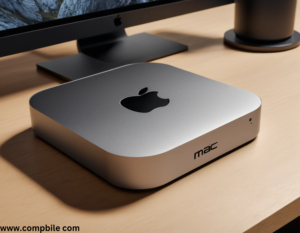
Power Efficiency
- One of the standout
- features of the M1 and M2 chips is their energy efficiency. This translates to a quieter, cooler machine, as they use significantly less power than Intel-based Mac Minis while still offering improved overall performance. This is ideal for users who want to run demanding applications but don’t want their computer to overheat or make a lot of noise.
Future-Proofing
- With Apple’s custom silicon
- (the M1 and M2 chips), the Mac Mini is future-proof for several years. Apple is heavily invested in its ARM architecture, meaning the software ecosystem for these chips will continue to improve, ensuring that the Mac Mini remains compatible with the latest software updates and apps for a long time.
macOS Ecosystem: - The macOS operating system
- is optimized for the hardware of the Mac Mini. This tight integration leads to a smooth and efficient experience, with excellent security features, regular updates, and a user-friendly interface. It also works seamlessly with other Apple devices, like iPhones, iPads, and Apple Watches, making it easy to share files, send messages, or use your phone as a hotspot.
Ventilation and Cooling: - Unlike some other
- compact desktops, the Mac Mini doesn’t compromise on cooling. The M1 and M2 models are known for their excellent thermal management, meaning the system can run for long periods without throttling performance due to overheating, which is especially important for more intensive tasks.
Comparison to Other Apple Desktops
display
Apple Mac Mini Desktop
- The iMac
- is an all-in-one solution, meaning it integrates the display, speakers, and camera, making it a more convenient option for users who want a single device without peripherals. However, the iMac can be more expensive due to this integrated screen, and it’s not as customizable in terms of storage and upgrades. The Mac Mini allows for more flexibility, letting users pick their own monitor, keyboard, and mouse. Plus, the Mac Mini’s small form factor means it takes up less space.

design
- The Mac Pro
- is the most powerful desktop in Apple’s lineup, designed for professional use with the highest-end performance requirements (e.g., video production studios, 3D modeling, scientific computing). It comes with a significantly higher price tag and is more suited for users who need ultra-high-end specs, multiple graphics cards, or extensive customization options. The Mac Mini, while very powerful with the M1/M2 chip, targets a different market: professionals and consumers who don’t need the full power of the Mac Pro but still want excellent performance at a lower price.
Mac Mini vs. MacBook Pro Laptop
- If you are debating between
- a Mac Mini and a MacBook Pro, a MacBook Pro offers portability, so you can work on the go, but it also comes at a premium price. The Mac Mini, on the other hand, is stationary and is designed for users who need a fixed desktop setup. If portability isn’t a concern, the Mac Mini provides comparable performance at a lower cost.
Use Cases
- Developer/Programming:
- If you’re a software developer or programmer, the Mac Mini provides great performance with its powerful chips and macOS, which is a popular platform for coding, especially for iOS and macOS app development. It also supports development environments like X code and Docker.
- Home Office or Small Business:
- For people setting up a home office or a small business environment, the Mac Mini is an ideal choice due to its powerful specs and space-saving design. Plus, macOS is known for being secure and easy to manage, which is a plus for small teams or remote workers.
Creative Workflows
- The Mac Mini is great
- for creative professionals—graphic designers, video editors, music producers, and photographers will all find it well-suited to their needs. Applications like Final Cut Pro, Logic Pro, and Adobe Photoshop run exceptionally well on the Mac Mini, especially with the M1 and M2 chips. The M2 version, in particular, is a solid choice for video editing or other GPU-heavy tasks, offering up to 10 GPU cores.
- Media Consumption & Home Theater Setup:
- Since the Mac Mini can handle 4K video and has a HDMI output, it’s perfect for setting up a home theater PC (HTPC). You can use it to stream content, edit media, or even run a home server with software like Plex or EMBY.
Prices & Configurations
- Mac Mini with M1 (2020, base model):
- Starts at $699
- 8GB RAM, 256GB SSD
- 8-core CPU, 8-core GPU
- For users who want an affordable, entry-level Mac that still delivers great performance.
Mac Mini with M2 2023, newer model
- Starts at $599 (base model)
- 8GB RAM, 256GB SSD
- 8-core CPU, 10-core GPU (higher performance)
- A great option for those who want more power without going to the MacBook Pro or iMac.
Mac Mini with M2 Pro 2023
- Starts at $1,299
- 16GB RAM, 512GB SSD
- 10-core CPU, 16-core GPU
- A more professional option for users who need extra performance for tasks like video editing, software development, or other intensive workflows.
Get article on pdf file… click now
…………… Apple Mac Mini Desktop …………..

